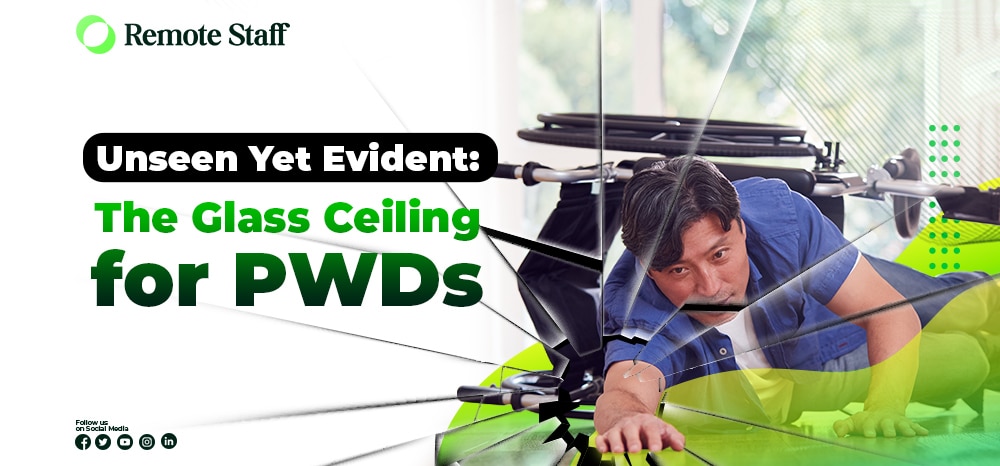Have you ever wondered why there are generally fewer female CEOs than male ones? Or why is it that minorities and persons with disabilities (PWDs) find it more difficult to get leadership positions within a company? No matter how skilled or qualified they are, they’ll usually get passed over in favor of other employees.
What you have just witnessed or even experienced is called the glass ceiling. This refers to the invisible barrier that prevents people, most notably women and minorities, from attaining high-level positions in a company.
Although women and minorities are the most prominent group experiencing glass ceilings, there is also a glass ceiling for PWDs. Despite the new opportunities given to PWDs thanks to online jobs, many challenges toward full workplace equality remain.
If you haven’t guessed it yet, this article will be about the glass ceiling, specifically, the glass ceiling for PWDs. This includes what causes this glass ceiling to ways it can be overcome. In addition, I will also discuss what the meaning of a glass ceiling is, as well as some glass ceiling examples.

What Is the Glass Ceiling?
Before we discuss the glass ceiling for PWDs, let’s have a more thorough look at the meaning of a glass ceiling. The glass ceiling refers to the various social barriers preventing people from receiving promotions to the top jobs within the company. These social barriers are often biases unrelated to the employee’s qualifications for the position.
When talking about the glass ceiling, we usually refer to the challenges faced by women and minorities. This is because they’re the ones who experience this kind of discrimination in the workplace. In fact, the term was first developed specifically to address the bias against women in leadership positions.
An example of a glass ceiling is when a woman experiences gossip-mongering from her co-workers after receiving a promotion. Yes, she received the promotion. But in doing so, she’s exposed to gossip regarding how she received her promotion. This could undermine her authority and cause doubt about whether she deserved her position.

The Glass Ceiling for PWDs.
Unfortunately, women and minorities aren’t the only ones who encounter glass ceilings at work. One of the main challenges for PWD workers, either traditionally or online, is the glass ceiling. Unlike the glass ceiling regarding women and minorities, however, the glass ceiling for PWD workers isn’t as talked about as the previous two.
Because of this lack of awareness, PWD workers in higher positions tend to conceal their conditions from their co-workers. This further reinforces the glass ceiling since if nobody’s complaining, it doesn’t exist, right?
Aside from this, other factors that cause the glass ceiling for PWDs include the following:

Existing Bias Against Their Conditions.
Because of their conditions, it is easy for their employers and co-workers to underestimate their capabilities. This could lead to employers not considering PWD workers for positions of importance, even if their track record proves they’re more than worthy. In worse cases, they won’t even hire them just because of their disability.
Aside from their employers, the co-workers of remote PWD workers also inadvertently contribute to reinforcing this bias against them. There’s nothing wrong with offering your assistance to a co-worker in need. But if you end up doing their jobs for them because you think they can’t do it, then we have a problem.

Accommodating the Needs of PWD Workers Is Challenging.
Another reason why the glass ceiling for PWDs exists is because companies find it difficult and expensive to accommodate them within their workforce. Having the necessary support tools is essential to a PWD worker’s career. However, these assistive technologies usually aren’t cheap, nor are they easily accessible.
In addition to purchasing assistive technologies, some PWD workers also require specialized areas to work on. Companies also need to conduct seminars on how regular employees should interact with their PWD co-workers. Combine these factors together, and it can be difficult for companies to adjust to their needs.

How Companies and Individuals Can Break This Glass Ceiling?
Fortunately, there have been efforts by companies and PWDs themselves to break this glass ceiling and pave the way for more inclusivity in the workplace. These includes:

Spreading Awareness of the Glass Ceiling.
The first way to help break this glass ceiling is acknowledging it exists in the first place. Raising awareness allows companies to assess whether their setup is inclusive or not. They can then implement changes that will help them gain new PWD employees and retain current ones.
For PWD workers, it lets them share their stories and air out their concerns to their bosses. One of the reasons why bosses aren’t promoting their PWD workers is that they believe they’re satisfied with their current position. This allows them to prove themselves worthy of a promotion by their bosses.

Laws That Incentivizes Companies to Hire PWD Employees.
Another way, this time by the government, to help PWDs break their glass ceiling is through incentives. These are in Section 8 of RA 7277, also known as the Magna Carta for Disabled Persons. These are primarily reductions in the amount of tax needed to be paid by employers who have hired PWD workers and have improved their facilities to accommodate them.
Other than incentives, RA 7277 also ensures that workplaces are inclusive to PWD workers. These requirements range from the ever-present wheelchair ramps on most buildings; to the assurance that no PWD worker will ever be denied employment.

Let Capable PWDs Lead Group Projects.
This discussion on how to break the glass ceiling wouldn’t be complete without talking about this one. If a company truly wants to shatter the glass ceiling for their PWD workers, then they must be willing to give them chances to show their leadership skills.
And the best way to do this is by letting them lead group projects. However, do be careful not to baby them while doing so. The entire point of giving them a leadership role is to show what PWD workers are capable of. Giving PWD workers special treatment ruins your message and reinforces the glass ceiling instead.

Give More Remote Work Opportunities for PWD Workers.
When discussing the glass ceiling for PWDs, part of it is helping PWD workers get hired in the first place. One solution that many PWD workers have found to solve this challenge is shifting to a remote work setup.
In a remote work setup, they don’t need to worry about commuting anymore or how they’ll work without their assistive tools. In this case, why not take advantage of this by opening more remote jobs?

Not Just the Men, but the Women, Minorities, and PWDs Too.
And that is it! Here’s an overview of the glass ceiling, its causes, and how it prevents PWDs from advancing in their chosen careers. Just because it isn’t as talked about as the glass ceilings on women or minorities doesn’t mean that the glass ceiling for PWDs isn’t there. By ignoring this essential issue, we deny PWDs an opportunity to advance their careers.

